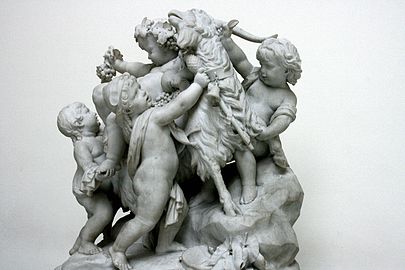
Charles Auguste Fraikin (14 June 1817 – 22 November 1893) was a Belgian neoclassical sculptor.
Life
[edit]Charles Auguste Fraikin was born in Herentals, United Kingdom of the Netherlands, on 14 June 1817.[1][2] He took drawing lessons from the age of twelve at the Royal Academy of Fine Arts in Antwerp. When he was thirteen, his father died. Fraikin therefore opted for practical training as a pharmacist.[3] He worked in the pharmacy of Auguste-Donat De Hemptinne, brother-in-law of François-Joseph Navez, painter and director of the Brussels Academy, who discovered his talent and encouraged him to continue in the arts.[4][5]
At the Salon van Brussel in 1845, Fraikin won a gold medal for the sculpture L'amour captif. Marble versions of it were later placed in the Royal Museums of Fine Arts of Belgium and the Hermitage. It brought him to the attention of the Belgian royal family, which led to new commissions. Among other things, he made a statue of King Leopold.
In addition to being a sculptor, Fraikin was also curator of the sculpture department of the Royal Museums of Fine Arts of Belgium.
At the end of his life he had donated his collection of plaster models to the city of Herentals. He witnessed the opening of his museum in the Cloth hall of Herentals. He died on 22 November 1893 in Schaarbeek.[2] After a church funeral he was buried close to the choir of Saint-Waldetrudis church.[3]
Incomplete list of works
[edit]- Allegory of the City of Brussels (1848), Place Rouppe/Rouppeplein
- Monument to the Counts of Egmont and Horn (1864), Square du Petit Sablon/Kleine Zavelsquare
- Eleven portal images for Brussels' Town Hall
- Mausoleum of Félix de Mérode in the Cathedral of St. Michael and St. Gudula
- Funerary statue of Ferdinand Nicolay at Laeken Cemetery
- Monument of Father Pierre-Jean De Smet (1878),[6] Church of Our Lady
- Mausoleum for Louise of Orléans (1859), Sint-Petrus-en-Pauluskerk
Gallery
[edit]-
Triumph of Bacchus
-
Sleep or Morpheus
-
Statue of Pieter-Jan de Smet
-
Tomb of Queen Louise
-
Detail of the monument to Egmont and Horne
-
City Hall Portal
Further reading
[edit]References
[edit]- ^ Baudouin, Piet (1991). Liebaers, Herman (ed.). Flemish Art from the Beginning Till Now. Mercatorfonds. p. 523. ISBN 9789061532620. Retrieved 26 November 2021.
- ^ a b "Charles Auguste Fraikin". RKD. Retrieved 26 November 2021.
- ^ a b Koninklijk Museum voor Schone Kunsten (Belgium) (2008). Heads on Shoulders Portrait Busts in the Low Countries 1600-1800. Snoeck. p. 68. Retrieved 26 November 2021.
- ^ Min, Eric (2016). Een schilder in Parijs Henri Evenepoel (1872-1899) (in Dutch). De Bezige Bij. ISBN 9789023497196.
- ^ Musée d'art moderne (Musées royaux des beaux-arts de Belgique) (1987). 275 [Tweehonderdvijfenzeventig] jaar onderwijs aan de Koninklijke Academie voor Schone Kunsten van Brussel (in French). Crédit Communal. p. 328. Retrieved 26 November 2021.
- ^ Pater Pieter Jan De Smet (Dendermonde)






Well, that’s interesting to know that Psilotum nudum are known as whisk ferns. Psilotum nudum is the commoner species of the two. While the P. flaccidum is a rare species and is found in the tropical islands. Both the species are usually epiphytic in habit and grow upon tree ferns. These species may also be terrestrial and grow in humus or in the crevices of the rocks.
View the detailed Guide of Psilotum nudum: Detailed Study Of Psilotum Nudum (Whisk Fern), Classification, Anatomy, Reproduction